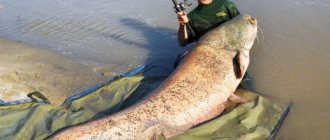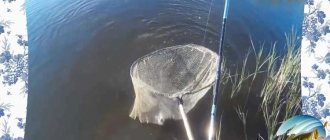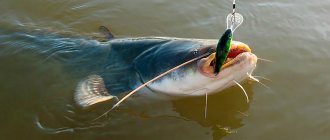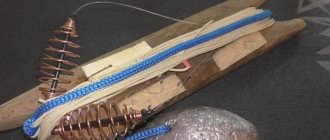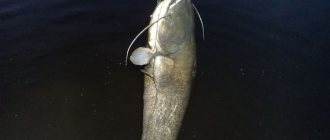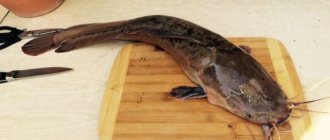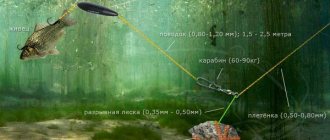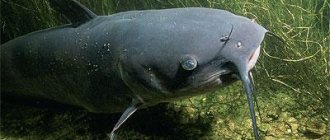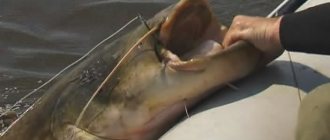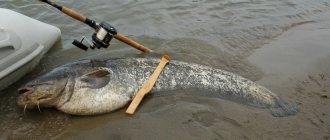What kind of Fish is this: Catfish | A few words about Soma
The Common catfish reaches a length of 5 meters and sometimes weighs up to 200 kilograms. A characteristic feature of this fish is the absence of scales.
It should also be noted that there is no adipose fin or spines. The color of catfish varies, but is predominantly brown, with shades of green and brown. White, only the ventral part.
But sometimes in reservoirs you can find rare specimens, predominantly white.
Young individuals feed on crustaceans, all kinds of waterfowl insects, as well as juveniles of other fish.
It would be completely wrong to think and assume that catfish only eat carrion. To a large extent, the diet of adult catfish directly depends on the presence of species and subspecies of fish living in the reservoir.
Catfish also love to eat shellfish. If a catfish is hungry, it will not disdain small animals and birds that swim on the surface of the water.
But still, the main diet and favorite delicacy of catfish is small fish. Among fishermen, catfish are generally considered predators, but this is not entirely correct, since they also eat plant foods.
Catfish are especially active at night. Consequently, during the daytime they are passive and rest under snags, submerged trees in holes.
During Winter Time, the Catfish is not active and it is useless to catch it. They gather in small groups (no more than ten fish) in pits.
In winter, it lies at the bottom and does not float out, even when the water temperature is below 8 degrees (in order to save energy).
But in order not to experience a lack of energy reserves in winter, fish eat a lot in the fall. At this time, she develops a reserve of fat.
Fishermen use this fact to their advantage, actively hunting for it in the autumn. Summer is the time of greatest activity for fish such as catfish.
In the Spring period, catfish begin to spawn (when the temperature is 20 degrees and above).
Fishermen go hunting at this time; within 20 days they have the opportunity to catch a decent catfish (this is exactly how long the spawning period lasts);
In the summer, it is quite possible to catch catfish after rain, at night or on a cloudy day.
Catfish - Freshwater Giant. Under Water with Andrey Shchukin | Video
☸ Where to look for a mustachioed one
The catfish differs from most other species not only in appearance, but also in behavior. Those who plan to catch it in broad daylight should know that it does not rush around the reservoir in search of food, but patiently waits for prey in a secluded place. To detect such a bed, you need to know well the depths and bottom topography of the reservoir.
First of all, it is worth examining the pits, or rather the exits from them. Catfish like deep places, from which they survive other fish that are not able to compete with them. But this does not mean that catfish can only be found at depth. Sometimes hunger drives this predator to the coastal zone, where there are plenty of small food fish. Having left the “lair” and moved closer to the shore, it sets up ambushes near dumps, rifts and other bottom anomalies. After heavy summer downpours, washing everything into the water, it can be found even at a depth of 1 meter.
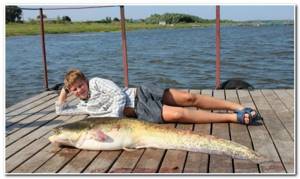
You can also stumble upon a catfish shelter under steep banks on which trees grow, and at the confluence of smaller waterways (small rivulets, streams). Such points attract predators with an abundance of food: insects, worms, mollusks and other living creatures.
Habitats. Finding and Catching Catfish | Where to look for Catfish?
Catfish is a freshwater fish. It is abundantly found in rivers, at great depths, in holes and deep edges. Coming out of its hiding place only for the purpose of prey and food.
At night, catfish can come closer to the shore, and many fishermen take advantage of this and successfully catch it on a donk.
In winter, Catfish “hibernate” and spend time motionless in their shelters.
To Find a Catfish, and especially to Catch It, You Need to Know These Important Points:
Its location is influenced not only by the time of day, but also by the time of year;
It does not belong to the category of active underwater inhabitants, so you cannot count on it to swim briskly and actively respond to bait.
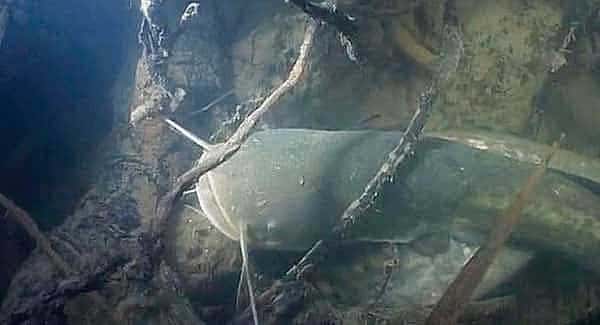
Apart from the time that Som spends searching for food, he spends almost all of his time on Rest, lying in holes and waiting for “Food” to pass by.
At the same time, you should not search for fish in the depths directly above the hole; try to fish close to the area adjacent to the hole.
It is best to go searching for Catfish by Boat, as the boat allows you to easily reach its habitats, namely the Deep Catfish.
As you know, Catfish prefer deeper places. Settling in the depths, they often “evict” other fish that are smaller in size and unable to compete with them.
However, it is known that the places they live do not always mean places for them to feed. Catfish almost always come aground from the depths, since only shallow sections of the river are abundantly saturated with small fish, and this is what attracts them.
He leaves his “lair” and goes closer to the shore. Here he hides near the Pits, Svals and Russes. Sometimes after heavy rains or on a quiet night in summer, fishermen may be lucky enough to see catfish off the Shore, at a Depth of up to 1 Meter.
Since the spring flood coincides with the appearance of large numbers of white fish in shallow waters, this forces catfish to go for prey.
Somyatniki fishermen need to carefully study the Bottom and the features of its relief. Fish most often hide near edges, exits from holes, rifts and deep drops.
In deep areas, you need to first of all pay attention to all kinds of snags, trees that have fallen into the water, or leaning close to the water;
You can also find Catfish in areas with the greatest concentration of all sorts of “Goodies” for such fish (Worms, Mice, Insects, Shellfish).
That is why it is necessary to swim to cliffs where trees and shrubs grow abundantly, as well as to areas where streams and rivers flow into. Quite often, catfish settle near an island, near holes, in depressions at the bottom.
Fishing technique
Secrets and tips for catfish hunting from the shore:
- It's better to prepare the place in advance. Around 8 pm, make a fire, place everything you need at hand, because at night in a hurry you will not find anything;
- Install about five donks at a distance from each other;
- Do not pull the prey after the first bite signals, wait for the line to tighten, and then hook. Catfish are very wary and can carefully taste bait;
- The fish can behave calmly after hooking. But make no mistake - at any second he will turn into a real beast and you need to be prepared for this.
- If the victim swims under a snag, loosen the fishing line and try to lure him out of there. You can throw stones there: the timid catfish will come out of its hiding place.
Features of catching catfish on a donk from a boat.
Donka fishing from a boat is both easier and more difficult at the same time. On the one hand, the rod of your donkey is shorter and more difficult to break. Plus - you are closer to the victim, it will be easier to pull out the trophy. But it’s inconvenient to fish out large catfish from a boat, and if it’s rubber, it’s downright dangerous. Large specimens will give you an unforgettable experience of “riding” on a pond. This fishing method has no more significant differences from the previous paragraph.
Popular Catfish Baits | How to Choose the Right Bait?
To choose the right Catfish Bait, you need to consider the following points:
Times of Day;
Season;
And the place of the intended catch.
The choice of bait and the success of fishing will depend on this. Properly selected, fresh and high-quality bait will ensure, at a minimum, a good bite, and, at a maximum, an excellent catch.
Many fishermen are aware of the fact that Catfish (unlike other fish) are quite ready to eat rotten meat or other carrion. If you use such a nozzle, it must have a corresponding specific smell.
But this causes negativity among most fishermen, so they refuse to use spoiled animal meat, poultry or fish.
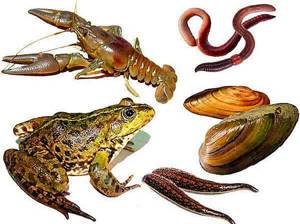
Bait for Catfish in the Autumn Period | 4 Most Popular Baits
It is best to go for Catfish in the Morning or Night Time. If there is fog, you can fish for the whole day, since Catfish are Activated in such weather as after the Rain.
Almost Any Bait is Suitable for Successful Fishing, but Experienced Fishermen Recommend the Following Options:
Crayfish necks;
Live bait;
Crawls;
Shellfish.
Chicken liver, sparrow (fried), frogs and even blood sausages are quite suitable.
It is best to have not one fishing rod, but several, so that for each of them you can test one or another bait, which one will bite better.
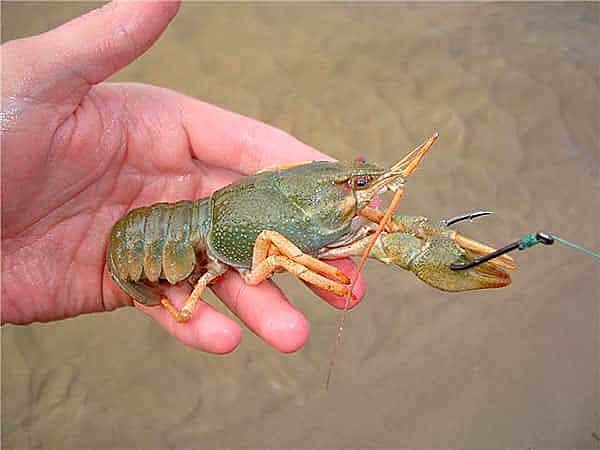
What Does Catfish Love Most? | List of Treats
The list of catfish's favorite treats is very long. We can say that he is practically omnivorous. As you know, it eats carrion with pleasure, which many other fish are not capable of.
Fishermen can today buy baits with the Scent of Blood in Specialized Stores. The fish bite well on this smell.
In the wild, Catfish are ready to feed on any birds, small fish, shellfish and other waterfowl.
At a certain period of time, they leave their shelters and go in search of food. If at this moment a waterfowl or fish comes into their field of vision, they will certainly try to attack it.
Fishermen note the special predilection of catfish for worms, which is why they often use them as bait.
3 ways to improve your fish bite!

Over 15 years of active fishing, I have found many ways to improve the bite, and here are the most effective:
1. Bite activator . This pheromone additive attracts fish most strongly in cold and warm water. The Fish Hungry bite activator has proven itself to be excellent - Read more…
2. Tackle with increased sensitivity . You should first familiarize yourself with the features of using a particular type.
3. Pheromone baits . They attract the attention of fish, stimulate hunger and cause a schooling reflex, which allows you to collect a lot of fish in one place.
You can get the rest of the secrets of successful fishing for free by reading my other materials on the site.
3 ways to improve your fish bite!
Over 15 years of active fishing, I have found many ways to improve the bite, and here are the most effective:
1. Bite activator . This pheromone additive attracts fish most strongly in cold and warm water. The Fish Hungry bite activator has proven itself to be excellent - Read more…
2. Tackle with increased sensitivity . You should first familiarize yourself with the features of using a particular type.
3. Pheromone baits . They attract the attention of fish, stimulate hunger and cause a schooling reflex, which allows you to collect a lot of fish in one place.
You can get the rest of the secrets of successful fishing for free by reading my other materials on the site.
How to Catch Catfish on Donka | Real Chances of Catch
The good thing about fishing on Donka is that you can first catch live bait, and then use this live bait to catch catfish.
It is also possible to install a large number of donks, which can really increase the chances of catching.
This method of catching catfish has many advantages and is a leader among others.
Moreover, the peculiarities of fishing in the Summer and in the Spring are quite identical. In the spring, worms are usually used as bait.
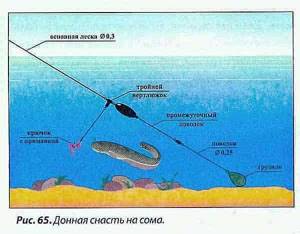
Donks come with or without a rod.
Since catfishing involves aggressive fishing, the rod for this must be especially durable with a high-quality reel.
Depending on the size of the trophy, the thickness of the fishing line will be selected. The breaking force must exceed the weight of the fish.
The depth of fishing and the strength of the current will affect the weight of the sinker.
Before fishing on Donka from the Shore, the fishing line must be attached to trees or bushes.
The fishing line is a strong nylon cord to which leashes are attached (diameter up to 0.8 millimeters).
The sinker is tied to the end of the cord. A single, double or triple hook (the size depends on the bait and the size of the catfish) is tied to the tackle.
How to Catch Catfish on Donka from a Boat
It is recommended to fish from a boat during the day.
If you are fishing with a rod, then you need to take care of a stand for it.
Loosen the friction brake of the reel;
Prepare the signaling device.
To fish without a rod, you need to attach powerful sticks or choose stronger branches.
You need to remember that the catfish is a large river specimen that is capable of quickly and adroitly responding to bait. The fisherman will need maximum effort and skill.
It is better to fish from the shore at night. Each fisherman has his own habits and preferences.
After the catfish is hooked, it fights for its life. Since the catfish is very heavy and incredibly strong, the task for the fisherman is not an easy one.
After hooking, you need to remain calm. If the catfish rushes down, you should not hold the reel or line with your hand. You also don’t need to hold the brake so that the catfish doesn’t break the line.
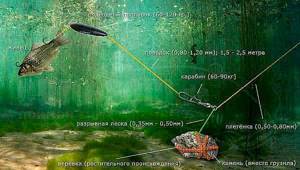
Catching Autumn Catfish on Donka from a Boat | Video
After stopping the catfish, you need to work with the rod. It needs to be raised (in a vertical position), the fish should be pulled in, lowered, the fishing line should be reeled in, and the slack should be picked up.
Catfish can interrupt fishing with jerks. It also happens that landing a catfish (especially if it is particularly heavy) takes a lot of time (an hour or more). The entire procedure should be carried out in a sitting position.
If fishing is done from a Kayak or Inflatable Boat, most often the Catfish is towed to the shore. In the case when the catfish comes close to the hole, it cannot be moved, and it is necessary to remove the anchor.
Catfish are taken into the boat using Hands, a Landing Net or a Hook. The hook must be sharp and durable. Without proper experience, it is difficult to hook it under the jaw of a fish.
It is best to work with two fishermen. One will control the hook, the other will hold the rod.
When using a landing net, you need to lower it into the water and bring fish into it. The landing net should contain part of the fish's body with its head. But it is most convenient to use this method for pulling catfish ashore.
Experienced fishermen pull out not very large catfish with their hands, grabbing them by the jaw (lower). Large fish are pulled into the boat by being grabbed under the gills.
Important Condition: Soma is tired when he is no longer able to resist well.
Necessary Equipment for Soma | 5 Things We Need
To catch catfish on Donka you will need the following equipment components:
Rod;
Hooks;
Cargo;
Coil;
Fishing line;
The rod must be very powerful, the reel must be equipped with a good spool (up to three hundred meters of fishing line). The fishing line should also be super strong, with a cord diameter of up to 0.6 mm.
Braid has its advantages, in particular, excellent breaking load resistance. At the same time, the fishing line is hardly damaged by stones or shells.
The speed of the current and the characteristics of the bait affect the weight and shape of the sinker. A heavy load will be required when using fish, crayfish, and frogs as bait.
Since a strong fishing line, when in water, forms significant resistance, it is necessary to increase the load or choose its corrugated version; another way is to reduce the diameter of the fishing line.
Universal Equipment for Catfish Catching. Tackle with Underwater Float | Video
A double or triple hook is used when fishing for crayfish, live bait, and frogs. When using chicken livers or crawlers as bait, a single hook is sufficient.
It is important to select a hook based on the size of the fish the fisherman intends to catch. When choosing a sinker, it does not matter whether it is sliding or standard. In a stuck place, a blind load is used. In other cases, a sliding design is preferable.
Fishing tactics
One of the most striking examples of how to catch catfish on a donk is fishing at night using feeder equipment. The feeder is a bottom tackle equipped with a feeder. The presence of a feeder allows you to constantly feed the fish, thereby increasing the chances of a bite.
Night fishing for donka has a big advantage - the absence of sultry heat. The equipment and bait should be prepared while it is still light. The composition of summer bait includes 70% ingredients of animal origin and 30% plant food. During night fishing on the feeder, it is necessary to make a starting feeding, after which a wait-and-see tactic is applied. Recasts should be done at intervals of no more than once every half hour.
Be prepared for the fact that there won’t be an immediate bite. It will take catfish about half an hour to smell the bait. Catfish bites may differ: the top of the rod may only sway slightly, or there may even be a sharp tilt. In any case, as soon as you notice a bite, hook it. You must know and be prepared for the fact that even the smallest catfish will stubbornly resist. Therefore, fishing for fish is the most difficult moment in catching this predator.
When fishing for catfish, be patient and be very careful. You shouldn’t try to pull the fish ashore immediately after hooking. First, try to tire him out. If it happens that the catfish caught on the hook sank to the bottom and lay there, you need to sharply tap the rod with a stick. The mustachioed man's panicky fear of a sudden knock will make him rise up.
The line must be kept in constant tension; guide the predator from one side to the other. When the catfish begins to turn its belly up, this will mean that it is tired. After this, drag it to the shore; at shallow depths the fish will offer less resistance. Grab it under the gills and pull it out.
To summarize how to catch catfish from the shore, we can highlight the following:
- Catfish is a nocturnal fish that loves darkness and silence;
- The predator lives at depth in holes, near snags and sunken trees;
- Considering the habits of the fish, it is better to catch it on the bottom;
- Select high-quality equipment elements with high load capacity and strength;
- The bait should be mobile and have an attractive smell;
- It is better to place the donk at the exit from the pit;
- After hooking, the catfish must be tired, and then taken to shallow water, where its chances of resistance are reduced to zero.
The process of catching catfish is quite difficult, but at the same time very enjoyable. Be patient, apply the acquired knowledge and then the result will not be long in coming. Happy fishing!
Catching catfish on a donk - video on the river
Catching catfish on a donk from the shore - video with an underwater float
How to catch catfish on a donk (video)
How to catch catfish from the shore: video
Catching catfish from the shore - video
How to Catch Catfish using Kwok | Why is Kwok needed?
Kwok fishing has been popular for a very long time. This method has certain features: with the help of kwok, fish are attracted. You need to catch catfish from a boat in the pits.
Fish Reacts to Sounds and the result is Successful Fishing and Great Catch. There is information that this method of fishing was used in ancient times (under Homer).
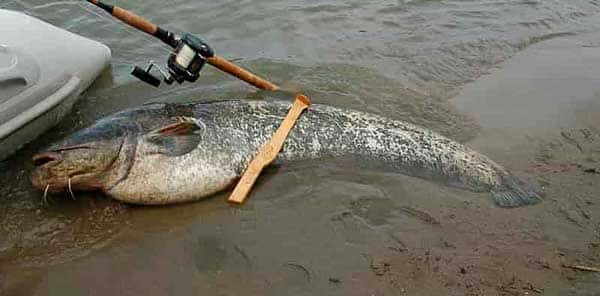
Experts recommend taking special care to select the right Kwok that can attract the attention of catfish. Similar sounds occur when catfish grab prey.
This makes it easier to attract and catch catfish in the usual way. The boat should drift with the current.
Fishing rods are installed on the side and on the sides, the bait is lowered to a depth of seven meters (under the boat). The pause between the croaks (three beats) is 15 seconds.
After the boat has sailed through the desired zone, you need to return to repeat the rafting.
When fishing, the catfish must be thoroughly tired, after which it is slowly brought to the boat. It's better to work together. One fisherman wields a hook, the second pulls out the fish in all possible ways.
Catching Catfish with Kwok: The Most Effective Method. Issue 57 | Video
What you need to catch catfish with a quok.
For this kind of fishing, first of all you will need: a boat, a water sail, an echo sounder, a quok and tackle. Catching catfish with a kwok is an active fishing activity that takes place from a boat or boat. Moreover, the boat constantly drifts with the current or with the wind. The boat can be anything - inflatable made of PVC, metal or wood. It can be oared, motorized or even sailed. Small or large, with a low or high side - it doesn’t matter to the catfish. I most often boat from a small, single-seater boat. It fits very easily into the trunk of a car, does not require much space and is quick to assemble. There are simply no separate requirements for the boat as a whole.
Even from a small boat you can fight serious-sized fish.
So, if you don’t have a motor, it doesn’t matter. Of course, actively moving around the most promising places in a short time will be to your advantage. But even on oars you can quite successfully master the kwok.
Sail.
A water sail is another necessary component of fishing.
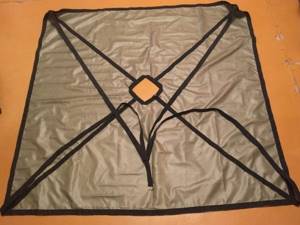
WATER SAIL.
The boat should constantly drift with the current if you are fishing on a river. And if a strong wind blows against the jet, the water sail will still pull the boat in the direction you want. This is a key point when catching catfish with a kwok. In simple words, the bait should drift with the current and look as natural as possible for the catfish.
Echo sounder.

An echo sounder today is essential for successful nodding. Of course, before, for hundreds of years, they managed just fine without it and successfully caught fish. Today, the presence of an echo sounder in a boat will make fishing as productive as possible. The main tasks of an echo sounder: 1) Quickly navigate along the bottom topography. Which is very helpful in an unfamiliar body of water to find promising areas in a short time. 2) React immediately when bottom obstacles appear. When the boat is drifting, gear can get caught in flooded bushes or trees. The echo sounder will show the obstacle and you can avoid getting caught in advance. 3) And most importantly! The echo sounder will show the catfish's approach to the bait in real time.
Often, many fishermen mistakenly believe that catfish feed exclusively on carrion. In fact, it is an active predator. The main diet of large specimens consists of fish.
Kwok.
I want to debunk the myth right away - kwok is not magic. It has nothing mysterious or supernatural about it. And any angler can master this fishing if they have the desire. Kwok is not a magic pipe, it is just an instrument. Same as a rod or reel. Most often, kwok is made of wood or metal, less often of composite materials.

KWOK
Kwok consists of a base and a nickel. The base, in turn, can be divided into a handle and a knife. The knife is a refined part of the kwok, which allows you to work with this tool for many hours.
The principle of operation is not complicated. The fisherman needs to create an air bubble, pull it under water and bring it to the surface. These actions create a certain sound that looks like a small explosion. In essence, this is a water hammer that acts on the catfish as an irritant.
What is Kwok? How is It Made? | What to Look for When Purchasing?
In the past, Kwok was made from Wood, especially from Apple Tree. Kwok may differ from other specimens in its design.
Today, homemade samples are often used. Its sound depends on its size and shape and not at all on the material from which it is made.
Components of Kwok:
Knife;
Lever;
Heel.
The handle today is made from Maple or Apple Wood. Then they give it the desired shape, treat it with a special impregnation, and then varnish it.
The knife is often made on the basis of a duralumin plate. To make the patch, use epoxy resin. The knife (it should have 2 holes) is clamped in a vice (at an angle), then a mold is made for pouring.
The knife is immersed five centimeters in the snout. Then the form hardens and requires sanding and filing. The purchased Kwok often has to be modified to fit the desired sample.
Important Points When Buying Kwoka:
The working part is ideally well polished;
The angle between the knife and the handle is 60 ° C;
The handle is normally painted and sanded perfectly.
In addition to Kwok, to catch catfish you will need:
Reliable fishing line that can withstand a significant load;
A short, rigid rod (if used), with rings;
Leash (average thickness - 0.6 mm, length - 1 m);
Reliable hook;
Sinker.
Step-by-step instructions for making donka with your own hands
To begin with, I would like to add a little about the pros and cons of donka. Experienced anglers love it, despite other modern fishing accessories. For a successful hunt, the hunter must know the habitats of his prey, the behavior and advantages of the donkey. Its main positive qualities are, of course, the possibility of fishing with a donk at a great distance from the shore or boat and the ability to control the bite, especially in bad weather. You can also install additional alarms (both sound and light) on the donk. Layout in water:
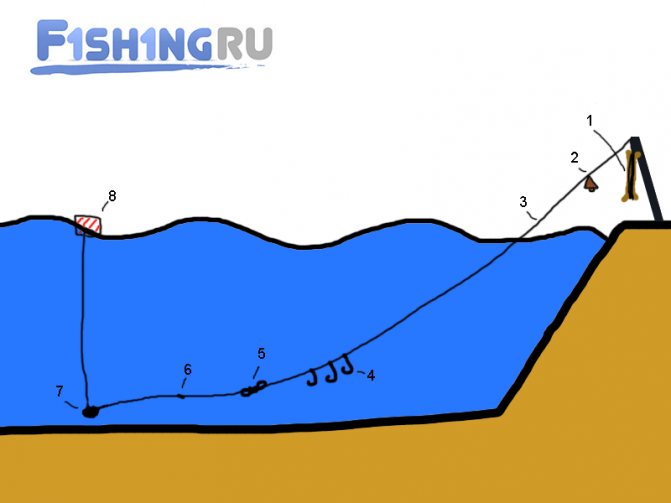
1. Motovitsa. 2. Bell. 3. Fishing line. 4. Hooks. 5. Swivel. 6. Rubber bands. 7. Sinker. 8. Reference buoy.
Bottom tackle makes it possible to fish and feed fish at the same time and fish at great depths, which is an undeniable advantage over other fishing methods. The disadvantages include difficulties when fishing in places with large vegetation and snags on the bottom, and the inability to fish in mountain rivers with large currents.
Let's look at how to make a donk with a fishing rod with your own hands. You can go the simplest route, simply equipping a spinning rod purchased in advance at a fishing store, or you can use improvised items.
If the rod is a spinning rod, then it must be strong and elastic. It is also advisable to be light, because when biting a large individual, its weight will be enough for you to get quite tired. If your goal is small catfish, then you can choose a spinning rod for pike. Its price is lower than rods of greater strength, and it weighs less.
The length depends on the fishing method: from the shore it is better to use a longer “stick” to increase the casting range and accuracy, and from a boat a short spinning rod (no more than 2.5 meters) is also suitable; when fishing with a donk in a plumb line and not more than a meter at all. The process of making this donkey is no more complicated than a snack. The only difference is that the fishing line is passed through all the rings of the rod and wound onto the reel. The choice of coil was discussed earlier.
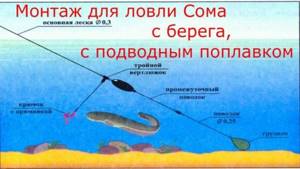
The bottom for fishing in the current is also not very different from the bait, you just need to improve it a little: place an underwater float in the middle of the leash or move the leash onto the fishing line using a swivel, then the bait will be above the bottom.
The rubber band is also in demand among the gurus of catfish fishing with donk. To make it you will need 2 skeins of monofilament: with a cross-section of 0.3 mm and a length of up to one hundred meters and 0.2 mm - up to 20 meters, 10 m of aircraft model elastic, catfish hooks, a metal or wooden reel, a weight and an alarm. Instructions for proper installation are as follows:
- A fishing line measuring 0.3 mm (20-50 meters) is wound on the reel. On the remainder of the fishing line, approximately 2 meters long, 5 loops are made for tying leashes.
- The leashes are made from fishing line with a diameter of 0.2 mm and a length of 0.2 m. A hook is tied to one end, and a loop must be made on the other. There should be slightly more leashes than loops on the reel.
- A washer with a pre-attached elastic band is attached to the main monofilament thread (at the end). It can increase by about 4-5 times, so its length depends on the fishing location. Having installed a three-meter elastic band, you can throw the donk 10-15 meters away from you.
- At the other end of our shock absorber you need to tie a half-meter cord with a weight at the end (it is better to use heavier objects, such as a brick, as a sinker).
To install such equipment, it is better to use a watercraft. You can also throw a rubber band from the shore. First of all, the load is thrown, after which the main thread is pulled until the hooks appear above the water level and the bait is attached. Next, we simply slowly release the fishing line and attach the bell.
You can make a donk with a feeder, which is used instead of a load. The further the donk is thrown, the heavier the feeder should be. You can buy it in a store, or you can make it yourself from wire or other available materials. When fishing with a donk in still water, any cage shape is suitable, but in a current you need a rectangular or triangular feeder to resist the flow (plus it should be more massive). During the current, the rod is placed perpendicular to the plane of the shore to tension the line. For fishing in the current, a semi-closed feeder is used, while in still water, a completely closed one is used.
Watch how to make a donka with your own hands:
How to Catch Catfish with Spinning Rod | Less Current Method
Spinning is a less popular method of catching catfish due to their heavy weight. At the same time, this method is quite convenient for catching small individuals.
The most commonly used method is jig fishing. In this case, dead fish are used as bait, which are lowered to great depths.
First of all, you need to study the deep edges. The bait is brought slowly, periodically moving it along the bottom. Ascents should be smooth.
It is best to fish in the spring, at night, using Wobblers. The cast is made along the sides of the hole, the bait is stopped in its center, after which it floats up.
A sharp hook is used when the catfish shows particular resistance.
How to catch catfish
There are many modern ways to successfully hunt this giant fish. Fortunately, accessible and inexpensive technical equipment for fishing can be purchased at any specialized store. In the description of the article, we will focus on the more common methods, which are easier and cheaper to organize, and in terms of catch results, which will not be inferior to high-tech methods.
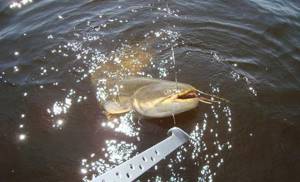
The easiest way to catch catfish is with bottom gear, which is point-mounted in promising fish habitats. The installation for catching catfish with a donkey has the lowest material consumption and is easy to implement. To equip the so-called suspension, you will need one and a half dozen meters of nylon cord with a diameter of 1.5–3 mm, a wooden reel, Kevlar leashes from 30 cm long, lead sliding weights, depending on the strength of the current, their weight varies from 100 to 500 grams and a powerful single a hook capable of withstanding a bending load of at least 100 kg.
Fishing with hooks is a passive fishing method and does not require the angler to constantly be present and control the gear. Similar equipment is also used for catching baleen with quok. With this method, catfish fishing is carried out from a boat, pulling bait with a parallel bait with a quok while the fisherman floats downstream. A similar method of semi-passive fishing includes the now popular trolling, when the bait is a deep-sea wobbler or spinner with strong vibration characteristics. In these methods, an important factor is the choice of the correct trajectory of the swimming device.
The fisherman, having presented the bait, constantly monitors the moment of bite and, if necessary, hooks the trophy. An active hunting method includes casting with a spinning rod. Catching catfish on the river in places where it stays is done with jig wiring using large-sized silicone vibrotails. Fishermen use each of the above methods with equal success throughout the entire season of hunting for the freshwater giant, only making adjustments to the fishing conditions in the body of water chosen for this.
How to catch catfish on a donk
When fishing with the bottom method, the main problem of the method is choosing the right location for installing the gear. The specifics of installing a harness require space for tying the gear, which in some cases is additionally ensured by the installation of wooden poles specially prepared for this purpose.
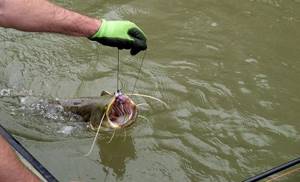
You can catch catfish with bottom gear both from the shore and from a boat. Having found a promising point, they string live bait onto the hook and lower the bait to the bottom, at a distance of 50–70 cm. The cord is tied to branches, cramps, or a pole stuck into the bank or bottom. The rate is left overnight. In the morning, they simply check the gear by lifting it. A fish that takes the bait will hook itself.
Another bottom fishing method involves installing a rubber bottom with five or ten leashes. A braided line of at least 0.3 mm in diameter is used as the main cord. A cut length of one hundred meters is equipped with a model of at least 1 mm thick and 30 meters long. 40 cm leashes are made from braided fishing line with half the diameter. You can also use fishing line with a diameter of 0.5 to 1 mm. The main cord of the donkey is knitted to a post firmly dug into the bank or to a tree trunk through a rubber shock absorber, which can be used as a casing-braided elastic band from a sports expander. The donka is equipped with an alarm, preferably with dual functions, which provide an audible signal and a visual signal, light, since fishing takes place in the dark. The result of the bite will also be a hard self-hooking of the fish, but the shock absorber will save you from breaking the tackle, which over time will tire the powerful trophy and will allow you to fish it out without much difficulty.
Fishing with kwok
In ancient times, fishermen noticed that the river monster is lured to the fishing site by sound and vibration waves, which are created by striking the water with a device called the kwok. The essence of fishing is to move the fisherman on a boat with the current or with the help of the wind with a bait pulled on a cord, lowered into the water column approximately 1/3 or 1/2 from the bottom. By hitting the water with a quok, the angler activates the fish and forces the predator to get out of the shelter. Feeling and seeing the bait, the fish comes out to attack.
Important! Kwok works in three frequent strokes with a break of fifteen seconds throughout the entire trajectory of the promising penetration.
Inactive catfish bait in the form of a fried chick or a toothless shell is used as bait. They are caught both in the light and in the dark.
Spinning fishing
Fishing for river catfish can also be successful using a spinning rod, which is equipped with a powerful reel with a 0.25 mm braided cord and artificial bait. The most effective fishing methods are using large oscillating spinners and silicone vibrating tails.
Important! The spoon is carried over underwater holes and ditches on slow, even retrieves, without pauses or lowering to the bottom.

Silicone baits are equipped with heavy jig heads and using the step-jigging method they break through riffles, dumps and other underwater natural ground anomalies. The bite is felt in the form of a dull strong blow followed by a sharp pull, after which the fisherman must be prepared for a long and grueling struggle based on winding and lowering the cord, the alternation of which brings the fish to complete fatigue.
Trolling
Trolling is carried out from a motorized watercraft using a powerful spinning rod with a weight of 40 to 90 grams and a length of at least three meters. Deep-sea large wobblers such as shad, fet and crank are used as bait. It is desirable that wobblers have their own animation with frequent amplitudes of play and create strong vibration waves. The color factor comes into the background, but at greater depths, acid and red colors will be a priority. The bait is released from the boat at least 50 meters and pulled at slow to medium speeds, allowing the wobbler to dig the bottom with a shovel. Attacks mostly occur at the exit from a pit or ditch. The feeling of a bite is identical to catching with a throw. Fishing does not differ in technique from the fishing method described above.
Spinning Equipment for Catfish Catching | 6 Must-Have Things
To Catfish Catfish You Will Require Reliable Equipment:
Powerful Rod;
Reel (Capable of withstanding Soma's weight and jerking);
Well sharpened, sharp hook;
Powerful fishing line (up to 2 meters);
Bait (Artificial and Live);
Wiring.
It will not be possible to catch very large fish, but with the right approach to the fishing process, choosing a place and time of day, you can get a good catch.
Catfish bite on spinning rod. Fishing Technique | Video
Where to catch catfish
Before asking yourself how and where to catch catfish, you must first decide on the choice of place for fishing. The most preferable point for catfish is a river with a pool, a cliff, and snags. The mustachioed giant also likes the sharp drop in the bottom of the reservoir. The weight of the catfish depends on the size of the reservoir, and the water temperature also plays a big role: the warmer the water, the greater the opportunity to find this fish in this river: catfish is a heat-loving fish.
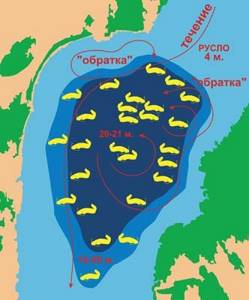
If you have decided on the river, it’s time to choose the places where the catfish likes to live. Small catfish can be found anywhere: holes, channel edges, large bays, cliffs, etc. In the morning, this little thing can be found even in shallow water. They are caught on a donka, on a fishing rod with a float with a bunch of worms. It is better to start fishing in the evening. At night, fishing continues, interrupted briefly, and ends at dawn. The catfish does not go overboard with food and baits; they treat them “democratically”; they also bite on artificial bait.
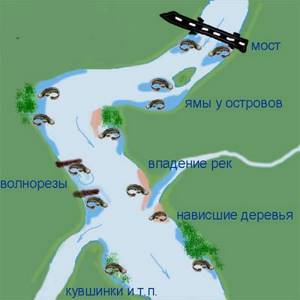
Large specimens live at depths, such as pits and barrels. You need to catch this predator at the time when it comes out of the hole. It will be most effective where the water flow is not too fast, that is, at the point where the steep bank transitions to the shallows. In such places it is better to put a bait-caster or a reinforced fishing rod with a reel. An experienced “somyatnik” usually places it on a flyer, tying the butt to a peg, which is driven in separately.
Catching Catfish by Trolling | Choosing the Right Equipment
Trolling is the Most Expensive Method of Catching Catfish.
First of all, expensive equipment will be required (when compared with other, simpler fishing methods). The boat should be directed along the Pit, near which the Catfish live.
The greatest chances of achieving a Positive Result are by lowering the bait to the very depths. Fishing is not at all difficult.
What is important here is:
Nozzle lowering range;
Speed of a sailing boat;
Wobbler parameters.
The clutch is clamped tightly after the fish bites the bait. Then you need to remove the loot. The gear must be durable and reliable, just like the bait.
In this case, you definitely need to go fishing in the 2nd. It will be more difficult for one fisherman to cope.
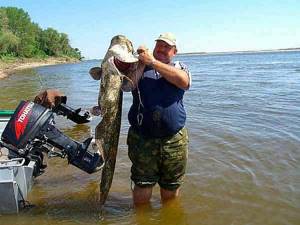
Catching Catfish by Trolling Requires Particularly Reliable and Expensive Equipment:
Powerboat;
Excellent spinning rods;
Echo sounder;
Nasty bait.
Additionally, you will need a Trolling glider for visibility of the water area, a fender, a hook, a navigator and other modern technological achievements, such as a Downrigger.
The correct choice of the necessary equipment, equipment, time of year and day, as well as compliance with all important rules will allow anglers to achieve maximum success.
Catching catfish is a rather difficult task, but with the right approach it can give fishermen maximum pleasure.
Let's learn to nod correctly.
You can also hear or read the opinion that the sound of a quok imitates something or someone. I am still inclined to believe that the sound that the kwok makes acts as an irritant. And the fish rises from the bottom to the surface to see what is happening. Making the correct kwok sound is not difficult, but it still doesn’t require much practice. The hand and forearm should be involved in this process. The involvement of the shoulder itself should be minimal. The fisherman’s task is to gently drive the kwok nickel under the surface of the water, increasing the speed of the heel and bringing it to the surface. The movements are not difficult, but require training until they become automatic.
The shape of a nickel is kwoka.
The nickel quok is very important. Its shape determines the ease of use of the instrument and the tonality of the sound. Conventionally, nickels can be divided into concave, convex and curved, or as they are called surf. I find it convenient to nod with concave heels in any weather. It doesn't matter whether it's calm or wave.
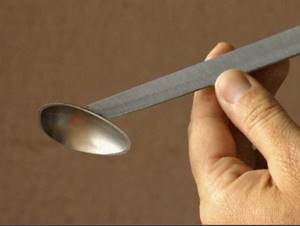
CONCAVED PITCH.
The convex penny is comfortable in calm weather.
Thanks to it, the sound turns out to be more sonorous and louder. Kwok with a convex heel
Surf quoks are located approximately in the middle, between concave and convex. They make sound quite easily, and the hand does not get tired even during long fishing trips.
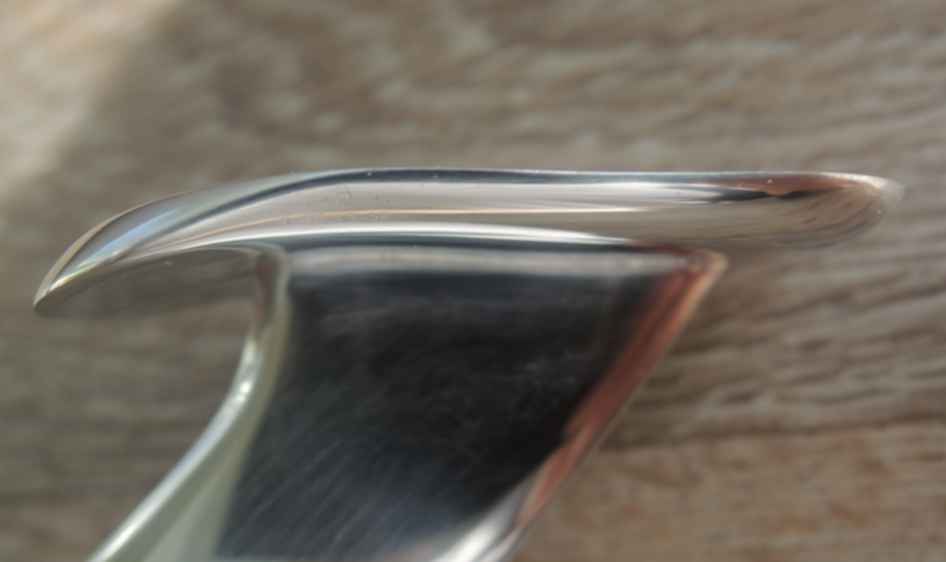
SURF KWOK
The sound of a kwok is another huge myth. Very often, novice fishermen are told that a certain fish works much better than others. Or he is only able to lift large catfish. Personally, I have come to the conclusion that any quok that can make a sound can raise a catfish.
In fact, there is not and cannot be any precise conclusion that this is right and this is not. Each angler works with the nook in his own way and there is no clear formula for correct nooking.
Kwok work.
I most often use a series of 5-6 hits, after which I pause for about 15-20 seconds. Sometimes I use quite long series of blows. And other times I do the opposite – long pauses.
Rods.
I prefer to use short but powerful rods in sizes 1.8 and up to 2.2 meters. And I use a spinning reel with cord. In my opinion, two rods are the golden mean. It is very convenient to differentiate between the two rods based on the depth of your baits. If I am fishing above a depth of 10 meters, then I lower the first nozzle 3 m, and the second about 6 meters from the surface of the water. Plus, my baits differ in composition and I can quickly switch to the one that the catfish prefers today.
Of course, you can talk about catching catfish with kwok for a very long time and it cannot fit into the size of one article. But in this one I promised to tell you only about the basics. I hope I succeeded! However, the topic of catfish fishing does not end here and there will definitely be a continuation. I can find out whether you liked the article or not from your comments. The comment section is open without any registration.
Just below you can enjoy a video of catching a catfish with a kwok.

